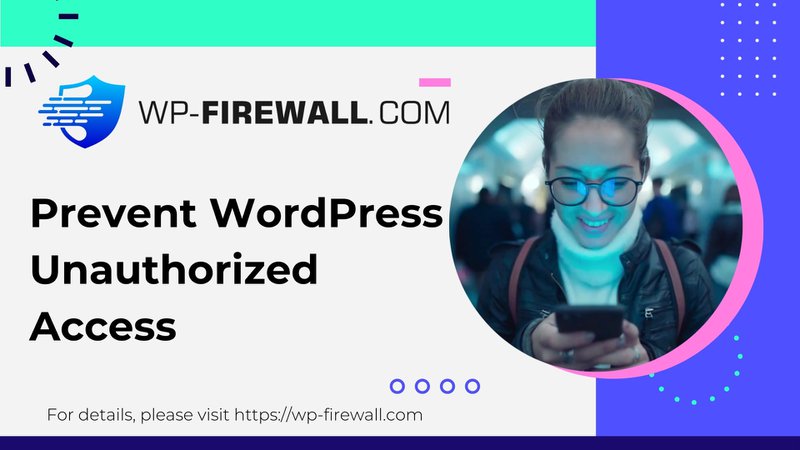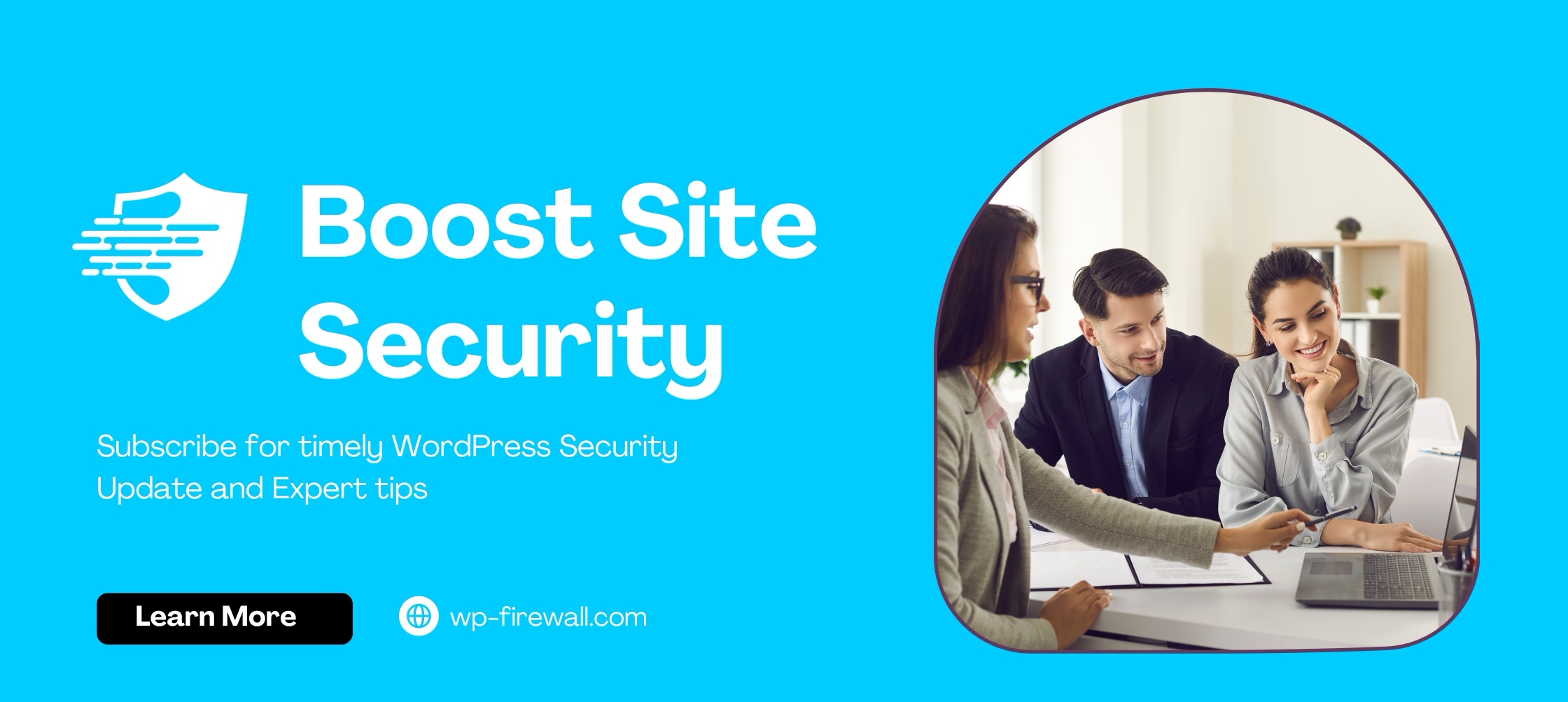
Understanding WordPress Privilege Escalation and How to Prevent Unauthorized Access
Imagine waking up one morning to find that your WordPress site has been compromised. Unfamiliar user accounts with administrative privileges have appeared, settings have been altered, and spam content is flooding your pages. This nightmare scenario is a reality for many WordPress site owners and is often the result of a security breach known as privilege escalation.
In this blog post, we will delve into the concept of privilege escalation, how it manifests in WordPress, and provide actionable strategies to protect your site. As a leading WordPress firewall plugin vendor and security service provider, WP-Firewall is committed to helping you safeguard your site against such threats.
What is Privilege Escalation in WordPress?
In the context of WordPress, "privilege" refers to the permissions or capabilities assigned to user accounts. These permissions dictate what users can and cannot do on your site, based on their roles such as Administrator, Editor, or Subscriber. Privilege escalation occurs when a user gains more permissions than they should have, allowing them to perform actions beyond their designated role.
For example, an Editor suddenly being able to manage plugins and settings like an Administrator is a classic case of privilege escalation. This can happen due to coding errors, vulnerabilities in plugins or themes, or misconfigurations. Hackers exploit these vulnerabilities to gain unauthorized access, manipulate site data, install malware, or even lock you out of your own website.
How Does Privilege Escalation Occur?
Privilege escalation can occur through various vulnerabilities and misconfigurations. Here are some common ways this can happen:
1. Vulnerabilities in Plugins and Themes
Outdated or poorly coded plugins and themes can be a gateway for hackers. If you don't keep your plugins and themes up to date, older versions with known vulnerabilities can be exploited. For instance, a recent vulnerability in the User Registration plugin put over 70,000 sites at risk.
2. Using Nulled Plugins and Themes
Nulled plugins and themes often come with malicious code embedded in them. Attackers can use this code to implant backdoors, granting them covert access to your site. This can lead to data breaches, data loss, or even a complete site takeover.
3. Breaking Authentication Mechanisms
Hackers can break authentication mechanisms through user enumeration or phishing attacks. User enumeration involves identifying valid usernames on a site, which can then be targeted for brute force attacks. Phishing attacks trick users into providing their login credentials through deceptive emails or sites.
4. SQL Injection (SQLi) and Cross-Site Scripting (XSS) Attacks
Weak input validation can allow hackers to inject malicious SQL or scripts to manipulate the database or hijack user sessions. Simplified or unsecured access to the database can make it easy for attackers to execute privileged operations.
5. Misconfigured User Roles and Permissions
Incorrectly assigning user roles or granting too broad permissions can open up opportunities for abuse. For example, assigning an Editor role to someone who should only be a Subscriber can lead to privilege escalation.
6. Direct Access to WordPress Files
Direct access to WordPress files through file indexing can expose sensitive files, leading to privilege escalation. Disabling file indexing is crucial to protect against unauthorized access.
How to Identify Privilege Escalation Attacks?
Identifying privilege escalation attacks can be challenging but is essential for maintaining your site's security. Here are some red flags to watch out for:
1. Unexpected Changes in Settings
If you notice changes in your site settings that you didn't make, it's a major warning sign. Check your site's activity logs for users and entries that you don't recognize.
2. New and Unknown User Accounts
Regularly check your user list. If new users with elevated roles like Admin or Editor appear without your approval, it could indicate a privilege escalation attack.
3. Unauthorized Content Changes
Unauthorized changes to posts, pages, or media files can be a strong indicator of privilege escalation. Keep an eye out for content modifications that you didn't approve.
4. Suspicious Activity in Activity Logs
Review your activity logs for unusual activity, such as multiple failed login attempts, unexpected role changes, or unfamiliar IP addresses. Suspicious actions recorded in these logs can reveal indicators of an ongoing or attempted privilege escalation attack.
How to Fix Privilege Escalation Attacks?
If you suspect your WordPress site has fallen victim to a privilege escalation attack, it's crucial to act swiftly. Here's a step-by-step guide to responding effectively:
1. Temporarily Take Down Your Website
Take down your website temporarily to prevent further unauthorized access and damage. Redirect visitors to a maintenance page to keep them informed while you address the issue.
2. Scan the Website Using WP-Firewall
Perform a thorough scan of your website using WP-Firewall's robust security tools. This will help you identify any malicious code, malware, or suspicious activity.
3. Reset All Passwords
Immediately reset all admin and user passwords and inform everyone about this change. Ensure that all user accounts, especially those with higher privileges, have strong and unique passwords. This step is crucial to prevent attackers from reusing compromised credentials.
4. Audit User Accounts
Conduct a complete audit of user accounts on your site. Remove any accounts that look suspicious or were created without your knowledge. Ensure that the roles and permissions for legitimate users are appropriate.
5. Remove Suspected Plugins or Themes
Uninstall any suspicious plugins or themes that might have been the entry point for the attack. Identify them by whether they were installed without your knowledge or if their names are dubious. Sometimes, sacrificing functionality temporarily is necessary for the sake of security. Ensure these components are thoroughly checked for vulnerabilities before considering reinstallation.
6. Reset Site Salts and Security Keys
Reset your site’s salts and security keys to add an extra layer of security by invalidating existing sessions and cookies. WP-Firewall offers this feature as part of its post-hack cleanup services, making it easier to secure your site’s authentication data.
7. Update Core, Plugins, and Themes
Ensure your WordPress core, plugins, and themes are up to date. Vulnerabilities in older versions can be a common entry point for attacks. Regular updates are essential to patch security gaps and protect your site against threats. WP-Firewall users can benefit from features such as staging sites and automatic backups that make the update process safer and smoother.
8. Implement 2FA or CAPTCHA
Add two-factor authentication (2FA) or CAPTCHA to your login process if you haven’t done so already. These security measures significantly reduce the risk of unauthorized access by adding another hurdle for attackers to overcome.
9. Monitor the Site
Keep a close eye on your site for some time after the attack. Regular security scans and activity monitoring will help you detect any new suspicious activity early, allowing you to respond promptly if needed.
What Are the Consequences of Privilege Escalation Attacks?
Privilege escalation attacks can have devastating effects on your WordPress site. When someone gains unauthorized higher privileges, the repercussions can be severe. Here’s what you need to be aware of:
1. Unauthorized Admin Access
One of the first things hackers aim for is unauthorized admin access. With admin privileges, they can change site settings, leading to misconfigurations or even site downtime. Imagine waking up to find your site completely offline or behaving strangely because a hacker has changed critical settings like user permissions or directory locations. This downtime can be a nightmare for both you and your clients.
2. Data Theft
Hackers with admin access can easily steal sensitive information from your site. This can include user data, financial records, and other confidential information stored on your website. Such data breaches can have severe legal and financial implications.
3. Content and File Modification
Once a hacker has escalated their privileges, they can change, add, or delete your site’s content and files. This isn’t just frustrating—it can also destroy your site’s integrity. Imagine finding inappropriate or fraudulent content on your site, or worse, seeing important files disappear.
4. Malware Installation
With higher privileges, hackers can install malware on your site. This malware can infect your visitors, steal their information, or even hijack their systems. It’s not just a risk for your site but also a danger to everyone who visits it.
5. Site Defacement
Hackers can deface your site, altering its appearance to display offensive or harmful content. Site defacement is not only embarrassing but also damaging to your brand’s reputation. It conveys a lack of security and can drive visitors away permanently.
6. SEO Impact and Google Blacklisting
A privilege escalation attack can seriously impact your SEO. If your site is compromised, search engines like Google might blacklist it to protect users. This leads to a significant drop in organic traffic as your site becomes almost invisible in search results. Recovering from such a blacklisting can be time-consuming and costly.
7. Loss of User Trust, Traffic, and Revenue
All these issues culminate in a massive blow to user trust. Visitors will be less likely to return to a site that’s been compromised. As your traffic dwindles, so does your revenue. The direct and indirect costs of a privilege escalation attack can be substantial, affecting not just your site’s security but also its profitability.
How to Protect Your WordPress Site from Privilege Escalation Attacks?
Preventing privilege escalation attacks is critical to maintaining the security and integrity of your WordPress site. By implementing a few proactive measures, you can significantly reduce the risk of such attacks.
1. Use WP-Firewall
One of the easiest ways to bolster your site’s security is by using a reliable security plugin like WP-Firewall. WP-Firewall provides comprehensive website security features such as malware scanning and cleaning, firewall protection, and bot protection. WP-Firewall can also help you detect and address vulnerabilities before they are exploited.
2. Regularly Update Your WordPress Core, Plugins, and Themes
Keeping your WordPress core, plugins, and themes updated is essential. Updates often include security patches that address known vulnerabilities. By staying current, you minimize the chances of attackers exploiting outdated software to escalate privileges.
3. Get Plugins and Themes from Reputable Sources Only
Always download plugins and themes from reputable sources. Avoid nulled versions, as they often contain hidden malicious code. Stick to official repositories like the WordPress Plugin Directory or trusted marketplaces to ensure you are using secure and reliable software.
4. Employ Strong Password Policies and 2FA
Implementing strong password policies is a crucial step in securing user accounts. Make sure that your users use complex passwords that combine letters, numbers, and special characters. Additionally, enable Two-Factor Authentication (2FA) to add an extra layer of security. 2FA ensures that even if a password is compromised, unauthorized access is still prevented by an additional verification step.
5. Regularly Audit User Roles and Permissions
Conduct regular audits of user roles and permissions on your site. Make sure that users only have the access they need to perform their tasks. Remove or restrict any unnecessary privileges. This practice limits the damage that can be done if a user account is compromised.
6. Take Regular Backups
Regular backups are your safety net in case of an attack. Ensure that you have a reliable backup solution in place and create backups frequently. Store them securely, away from your main site. In the event of a privilege escalation attack, having recent backups will allow you to restore your site to a safe state quickly. WP-Firewall users benefit from automated, offsite backups that can be retrieved with just one click.
Final Thoughts
While WordPress privilege escalation might seem like a daunting security issue, understanding its mechanics can significantly help you fortify your site’s defense against potential cyber threats. Implementing the preventative measures discussed, such as timely updates and stringent user role audits, can help you secure your site from unauthorized access.
Additionally, investing in a reliable security solution like WP-Firewall can provide further peace of mind by automating many critical security tasks, including monitoring and immediate threat mitigation. Remember, the safety of your WordPress site not only protects your content and user data but also preserves your online reputation and trustworthiness.
FAQs
Q1: What is privilege escalation in WordPress?
A1: Privilege escalation occurs when a user in WordPress gains access to capabilities and permissions beyond those allocated to their user role. This can lead to unauthorized actions and control over the website.
Q2: How does privilege escalation happen in WordPress?**
A2: Privilege escalation can occur through various vulnerabilities such as flaws in plugins or themes, misconfigurations in user permissions, or external attacks like SQL injections and phishing that exploit weaknesses in the website’s security.
Q3: What are the common signs of a privilege escalation attack?**
A3: Look out for unexpected changes to website settings, the presence of unknown user accounts, unauthorized changes to content, and unusual activity in the website’s logs.
Q4: Why is privilege escalation considered a serious security threat?**
A4: Privilege escalation can grant attackers unauthorized access to sensitive areas of a website, allowing them to steal data, modify content, inject malware, and potentially take complete control of the website.
Q5How can I protect my WordPress site from privilege escalation attacks?
A5: To protect your WordPress site, use security plugins like WP-Firewall, regularly update your WordPress core, plugins, and themes, only get plugins and themes from reputable sources, employ strong password policies and 2FA, regularly audit user roles and permissions, and take regular backups.
—
Final note:
By understanding and addressing the risks associated with privilege escalation, you can significantly enhance the security of your WordPress site. WP-Firewall is here to help you every step of the way, offering comprehensive security solutions tailored to meet the unique needs of WordPress users. Protect your site today and ensure peace of mind for you and your visitors.

